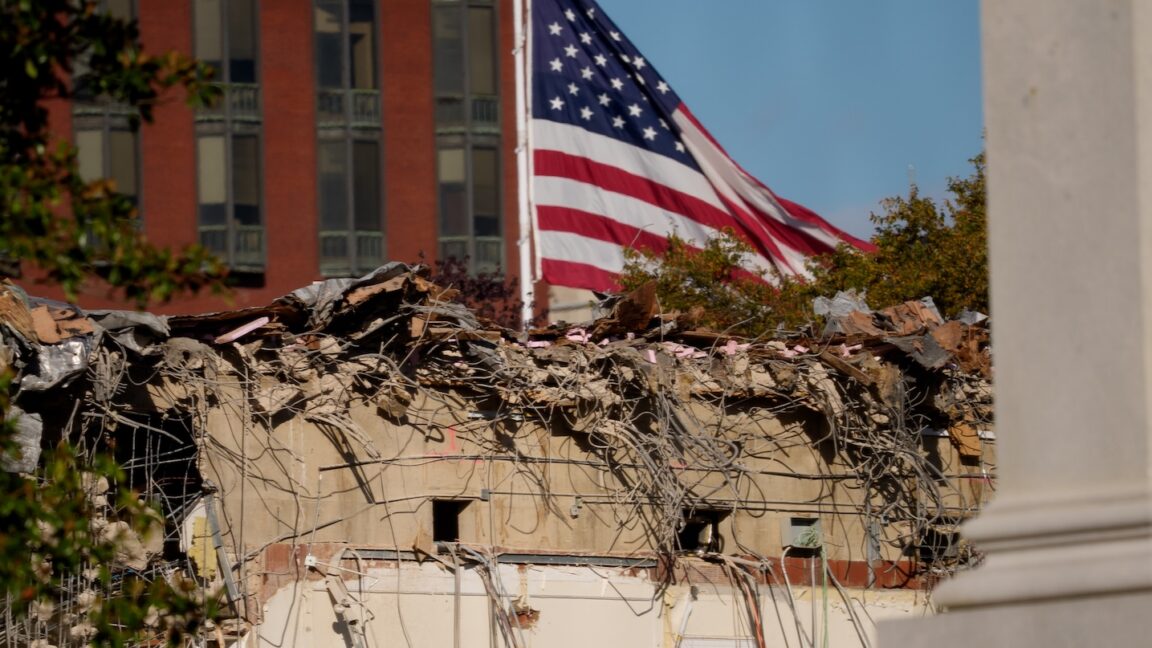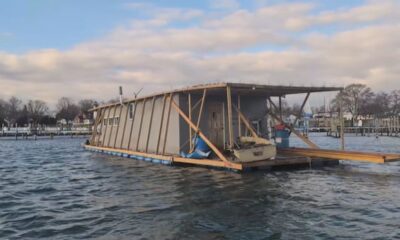Science
White House East Wing Demolition Begins for New Ballroom

Construction crews commenced demolition of the East Wing of the White House on October 3, 2023, marking a significant change to the presidential mansion’s landscape. This project is set to pave the way for a new 90,000-square-foot ballroom, projected to cost $300 million, a priority for President Donald Trump.
The decision to tear down the East Wing has sparked criticism from various quarters, including Democratic lawmakers and former White House staff members. Many were taken aback, particularly because just three months prior, Trump assured the public that the ballroom construction would not interfere with the existing structure. He maintained in July, “It won’t interfere with the current building. It’ll be near it but not touching it—and pays total respect to the existing building, which I’m the biggest fan of.”
Concerns about the project’s timing have also emerged. Senator Lisa Murkowski (R-Alaska) commented on the optics of demolishing part of the White House during an ongoing government shutdown. “People are saying, ‘Oh, the government’s being destroyed,’” she noted. “Well, now it looks like the White House is physically being destroyed.”
As demolition progressed, the US Secret Service restricted access to the Ellipse, a public park that overlooks the South Lawn of the White House. Journalists attempting to document the demolition were escorted out, according to reports from CNN’s Jim Sciutto. Employees of the Treasury Building, located across the street, were reportedly advised against sharing images of the demolition work.
In contrast to the criticism, some Trump supporters defended the project on social media, asserting that only a small portion of the East Wing’s facade would be affected. However, satellite images captured by Planet Labs revealed a different story. A photograph taken from one of their SkySat satellites on October 3 showed significant destruction of the 123-year-old annex.
The East Wing, originally constructed in 1902 and rebuilt in 1942 during the administration of Franklin D. Roosevelt, has historically housed the first lady’s staff. Planet Labs operates a fleet of small Earth-imaging satellites that provide daily mapping of the planet, offering valuable insights into various global events, including large-scale construction projects.
Funding for the new ballroom raises ethical questions, as some of the financial backers are prominent defense and aerospace contractors, including Lockheed Martin, Booz Allen Hamilton, and Palantir Technologies. While the Trump administration has stated that no public funds will be used for the project, the specific contributions from each donor remain undisclosed. This has led to concerns that these companies could gain favorable positions in future federal contract decisions.
In a historical context, this renovation represents the most substantial alteration to the White House grounds since former President Harry Truman‘s renovations. Unlike Truman’s renovations, which were overseen by Congress, this current project lacks such oversight, prompting further scrutiny.
The new ballroom is expected to be nearly twice the size of the White House itself, which has drawn criticism from historians. Edward Lengel, who served as chief historian of the White House Historical Association, expressed concern that the expansion could diminish the historical significance of the executive mansion. “It’s going to turn the executive mansion into an annex to the party space,” he remarked.
The White House has defended the demolition and construction, with Press Secretary Karoline Leavitt stating in a recent interview, “I believe there’s a lot of fake outrage right now because nearly every single president who has lived in this beautiful White House behind me has made modernizations and renovations of their own.”
Despite this assertion, many past renovations have been significantly less disruptive. For instance, former President Barack Obama merely repainted the White House tennis court, while Gerald Ford added an outdoor swimming pool. In contrast, the recent demolition of the East Wing has been visually dramatic and impactful, as evidenced by the satellite imagery.
As the renovation continues, the public remains divided on the implications of these changes to a historic landmark. Whether this transformation will enhance or diminish the legacy of the White House is a question that may linger long after the dust settles.
-

 Politics1 month ago
Politics1 month agoSecwepemc First Nation Seeks Aboriginal Title Over Kamloops Area
-

 World5 months ago
World5 months agoScientists Unearth Ancient Antarctic Ice to Unlock Climate Secrets
-

 Entertainment5 months ago
Entertainment5 months agoTrump and McCormick to Announce $70 Billion Energy Investments
-

 Science5 months ago
Science5 months agoFour Astronauts Return to Earth After International Space Station Mission
-

 Lifestyle5 months ago
Lifestyle5 months agoTransLink Launches Food Truck Program to Boost Revenue in Vancouver
-

 Lifestyle3 months ago
Lifestyle3 months agoManitoba’s Burger Champion Shines Again Amid Dining Innovations
-

 Technology3 months ago
Technology3 months agoApple Notes Enhances Functionality with Markdown Support in macOS 26
-

 Top Stories2 months ago
Top Stories2 months agoUrgent Update: Fatal Crash on Highway 99 Claims Life of Pitt Meadows Man
-

 Top Stories2 weeks ago
Top Stories2 weeks agoHomemade Houseboat ‘Neverlanding’ Captivates Lake Huron Voyagers
-

 Politics4 months ago
Politics4 months agoUkrainian Tennis Star Elina Svitolina Faces Death Threats Online
-

 Sports5 months ago
Sports5 months agoSearch Underway for Missing Hunter Amid Hokkaido Bear Emergency
-

 Politics5 months ago
Politics5 months agoCarney Engages First Nations Leaders at Development Law Summit





















